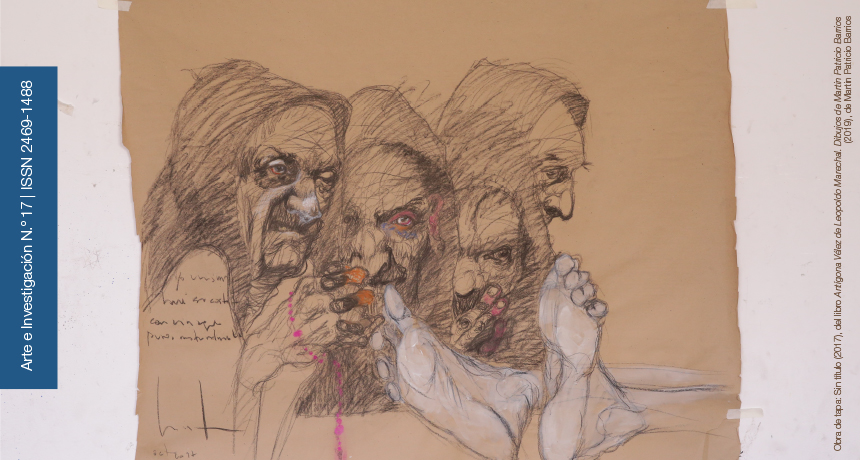Art of Juarez against Enforced Disappearances
DOI:
https://doi.org/10.24215/24691488e045Keywords:
Olga Guerra, forced disappearances, art, Ciudad Juarez, relational aestheticsAbstract
The purpose of this text is to describe how art develops themes related to violence, taking as a case study the books of the artist from Olga Guerra, who focuses on the forced disappearances that took place in this city. For this, the state of the question of this widespread problem in Mexican geography in general, and of the territory of Juarez in particular, is referred to first; to then expose the strategies with which artists approach this problem from the theory of relational aesthetics, in order to build spaces that favor human interrelations for the reconstruction of the social fabric.Downloads
References
Bourriaud, N. (2008). Estética relacional. Ciudad Autónoma de Buenos Aires, Argentina: Adriana Hidalgo Editora.
EFE. (13 de abril de 2016). Iniciativa de desapariciones forzadas del Senado exime al Estado de responsabilidades, denuncian ONGs. El Diario sin límites.
García Pereira, R. (2010). Juárez la Fea. Ciudad Juárez, México: Universidad Autónoma de Ciudad Juárez.
Grupo de Trabajo sobre Desapariciones Forzadas o Involuntarias. (2015). Informe annual del Grupo de Trabajo sobre las desapariciones forzadas o involuntarias [Informe anual]. Recuperado de https://www.ohchr.org/SP/Issues/Disappearances/Pages/Annual.aspx
Guasch, A. M. (2005). Los lugares de la memoria: el arte de archivar y recordar. Matèria. Revista internacional d’art, 5, 157-183. Recuperado de https://revistes.ub.edu/index.php/materia/article/view/11382
Halbwachs, M. [1991] (2002). Fragmentos de la Memoria Colectiva (Trad. Aguilar, M. A.). Athenea Digital, (2), 1-11. Recuperado de https://atheneadigital.net/article/view/n2-halbwachs/52-pdf-es
Herrera, M. C. y Olaya, V. (2011). Ciudades tatuadas: arte callejero, política y memorias visuales. Nómadas, (35), 99-116. Recuperado de http://nomadas.ucentral.edu.co/nomadas/pdf/nomadas_35/35_6HO_Ciudadestatuadas.pdf
Martínez Toyes, W. y Arellano Quiroga, J. (2012). Movilidad poblacional: efecto de la violencia e inseguridad en Ciudad Juárez. En M. Limas (Coord.), Inseguridad y violencia en Ciudad Juárez (pp. 45-62). Ciudad Juárez, México: Universidad Autónoma de Ciudad Juárez.
Méndez Llopis, C. (2016). Disidencias artísticas en Ciudad Juárez. Prácticas colaborativas en contextos de violencia. Kultur. Revista interdisciplinària sobre la cultura de la ciutat, 3(5), 177-210. doi: 10.6035/Kult-ur.2016.3.5.8
Mínguez-García, H. (2018). Resistirse al tiempo: los libros-arte y el cultivo de la memoria. Arte, individuo y sociedad, 30(3), 519-540. doi: 10.5209/ARIS.57828
Molina, J. (26 de febrero de 2015). Las desapariciones forzosas en México: «¿Cómo confiar en un Estado criminal?». Eldiario.es. Recuperado de http://www.eldiario.es/desalambre/desapariciones-forzosas-Mexico-confiar-criminal_0_360814819.html
Naciones Unidas. (2009). Desapariciones forzadas o involuntarias. En Folleto informativo Nº 6/Rev.3. Ginebra, Suiza: Oficina del Alto Comisionado de las Naciones Unidas para los Derechos Humanos. Recuperado de https://www.ohchr.org/Documents/Publications/FactSheet6Rev3_sp.pdf
Sábato, E. (2006). La resistencia. Ciudad Autónoma de Buenos Aires, Argentina: Seis Barral.
Salazar, S. y Curiel, M. (2012). Ciudad abatida: antropología de la(s) fatalidad(es). Ciudad Juárez, México: Universidad Autónoma de Ciudad Juárez.
Velázquez Vargas, M. S. y Martínez Canizales, G. (2012). La inseguridad en Ciudad Juárez desde la percepción de los ciudadanos. En M. Limas (Coord.), Inseguridad y violencia en Ciudad Juárez (pp. 63-82). Ciudad Juárez, México: Universidad Autónoma de Ciudad Juárez.
Villalpando, R. (28 de marzo de 2010). Falló el Operativo Conjunto Chihuahua, coinciden diversos sectores sociales. La Jornada, p. 7. Recuperado de http://www.jornada.unam.mx/2010/03/28/index.php?section=politica&article=007n1pol
Downloads
Published
How to Cite
Issue
Section
License
The acceptance of the manuscript by the magazine means the non-exclusive cession of the property rights of the authors in favour of the editor, who allows the reuse, after publication (post print), under a license Attribution-NonCommercial-NoDerivatives 4.0 International. According to these terms, the material can be copied and redistributed by any means or in any format as long as a) the author and original source of the publication are quoted (magazine and URL of the work), access to the license is provided and whether changes have been made is mentioned; and b) the material is not used for commercial purposes.
The cession of non-exclusive rights means that after the publication (post print) in Arte e Investigación the authors can publish their work in any language, means and format; in such cases it must be mentioned that the material was originally published in this magazine. Such cession also means the authorization of the authors for the work to be collected by SEDICI, the institutional archive of the National University of La Plata, and to be spread in the databases that the editorial team considers appropriate to increase the visibility of the publication and its authors.
Moreover, the magazine encourages the authors to deposit their productions in other institutional and thematic archives under the principle that offering the society the scientific and academic production without any restrictions contributes to a greater exchange of the global knowledge.


































